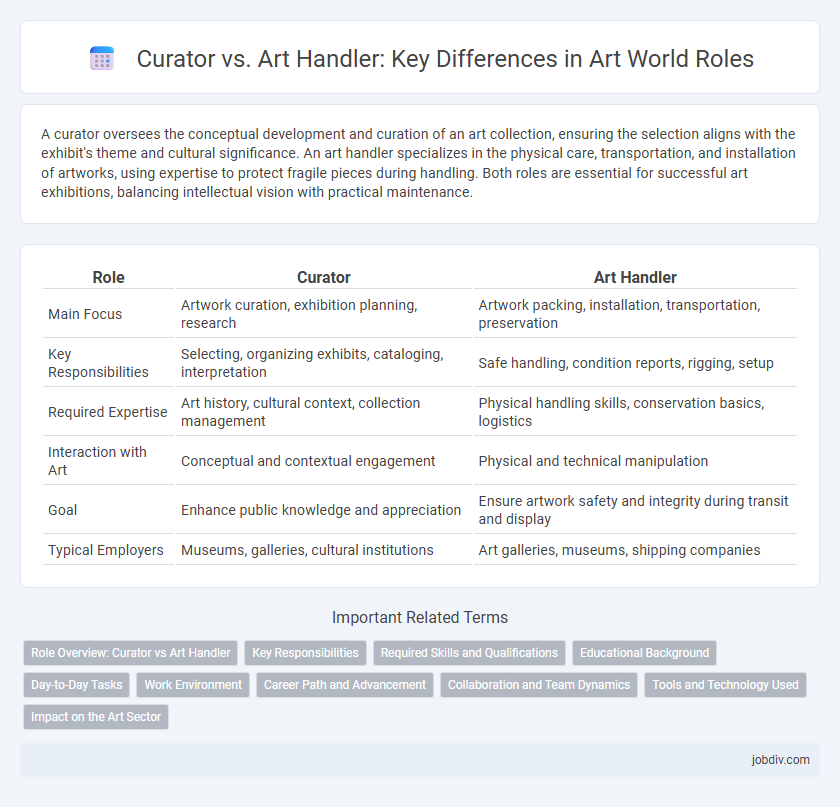A curator oversees the conceptual development and curation of an art collection, ensuring the selection aligns with the exhibit's theme and cultural significance. An art handler specializes in the physical care, transportation, and installation of artworks, using expertise to protect fragile pieces during handling. Both roles are essential for successful art exhibitions, balancing intellectual vision with practical maintenance.
Table of Comparison
| Role | Curator | Art Handler |
|---|---|---|
| Main Focus | Artwork curation, exhibition planning, research | Artwork packing, installation, transportation, preservation |
| Key Responsibilities | Selecting, organizing exhibits, cataloging, interpretation | Safe handling, condition reports, rigging, setup |
| Required Expertise | Art history, cultural context, collection management | Physical handling skills, conservation basics, logistics |
| Interaction with Art | Conceptual and contextual engagement | Physical and technical manipulation |
| Goal | Enhance public knowledge and appreciation | Ensure artwork safety and integrity during transit and display |
| Typical Employers | Museums, galleries, cultural institutions | Art galleries, museums, shipping companies |
Role Overview: Curator vs Art Handler
A curator manages art collections by researching, selecting, and interpreting artworks to create cohesive exhibitions that enhance public understanding and appreciation. An art handler specializes in the physical care, transportation, installation, and packing of artworks, ensuring their safety and preservation throughout handling processes. While curators drive the conceptual and educational aspects of exhibitions, art handlers focus on the technical and logistical support required to maintain the integrity of artworks.
Key Responsibilities
Curators manage art collections by researching, acquiring, and organizing exhibitions while ensuring the preservation and interpretation of artwork. Art handlers focus on the physical care, transportation, installation, and maintenance of artworks, using specialized techniques to prevent damage. Both roles require expertise in art history and conservation but differ in their operational and managerial responsibilities within museums or galleries.
Required Skills and Qualifications
Curators require expertise in art history, research, and collection management, often holding advanced degrees and possessing strong analytical and communication skills to develop exhibitions and educational programs. Art handlers need specialized knowledge in handling, packing, and installing artworks, with skills in materials science and physical dexterity, often supported by certifications in art handling and conservation techniques. Both roles demand attention to detail and a thorough understanding of art preservation standards to ensure the safety and integrity of collections.
Educational Background
Curators typically hold advanced degrees in art history, museum studies, or related fields, providing them with a deep understanding of art theory, history, and curation practices. Art handlers often have specialized training or certifications in art installation, conservation techniques, and logistics without necessarily requiring formal degrees. This educational distinction reflects the curator's role in exhibition design and interpretation, contrasting with the art handler's focus on the physical care and transportation of artworks.
Day-to-Day Tasks
Curators manage art collections by researching, selecting, and organizing exhibitions while developing educational programs to engage audiences. Art handlers are responsible for the physical care of artworks, including packing, transportation, installation, and maintenance to ensure preservation and safety. Both roles require collaboration to maintain the integrity and accessibility of art collections in museums and galleries.
Work Environment
Curators typically work in museums, galleries, or cultural institutions where they manage exhibitions, conduct research, and oversee collections in controlled environments. Art handlers operate primarily in storage facilities, shipping departments, and installation sites, ensuring the safe transport and physical care of artworks under varying conditions. Both roles require collaboration, but curators focus on intellectual and administrative tasks while art handlers engage in hands-on, physical work.
Career Path and Advancement
Art curators typically pursue advanced degrees in art history or museum studies and gain experience through internships or entry-level positions, leading to roles managing collections, exhibitions, and research projects. Art handlers often start with technical or vocational training, specializing in packing, transporting, and installing artworks, with career advancement involving mastering conservation techniques and supervisory responsibilities. Both paths offer opportunities for growth within galleries, museums, and auction houses, but curators advance toward scholarly and managerial roles, while handlers focus on operational and preservation expertise.
Collaboration and Team Dynamics
Curators and art handlers collaborate closely to ensure the successful exhibition and preservation of artworks, combining curatorial vision with technical expertise. Curators develop thematic narratives and select pieces, while art handlers manage the safe transportation, installation, and conservation of artworks. Their teamwork fosters a seamless integration of creative interpretation and practical execution, essential for museum and gallery operations.
Tools and Technology Used
Art curators utilize digital cataloging software and database management tools to organize, research, and document art collections, ensuring precise provenance and exhibition planning. Art handlers rely on specialized equipment such as custom crates, padded carts, climate-controlled storage systems, and advanced packing materials to safely transport and install artworks, minimizing the risk of damage. Both professions increasingly integrate technology like RFID tagging and environmental monitoring devices to enhance artwork preservation and security.
Impact on the Art Sector
Curators shape the art sector by selecting, interpreting, and presenting works, influencing public perception and cultural discourse. Art handlers ensure the safety and preservation of artworks through expert packaging, transportation, and installation, maintaining the integrity of pieces during exhibitions and storage. Both roles are critical, with curators driving intellectual engagement and art handlers safeguarding the physical longevity of art collections.
Curator vs Art Handler Infographic

 jobdiv.com
jobdiv.com